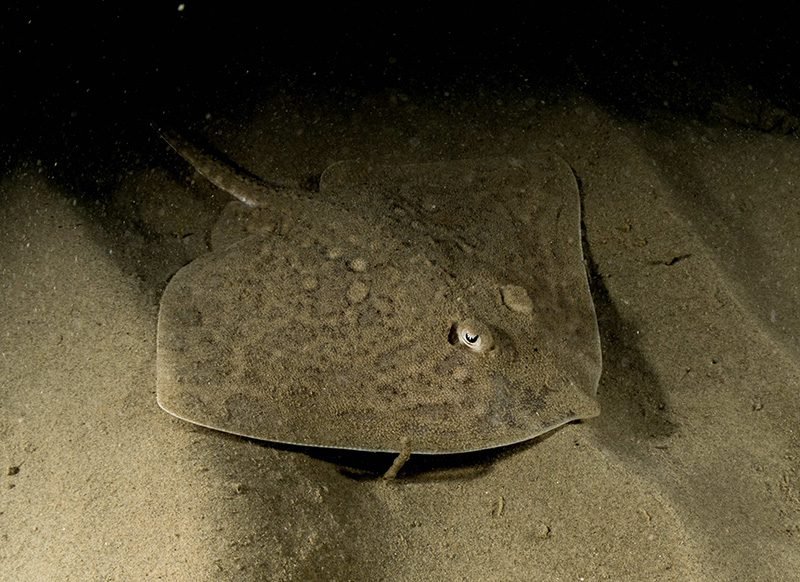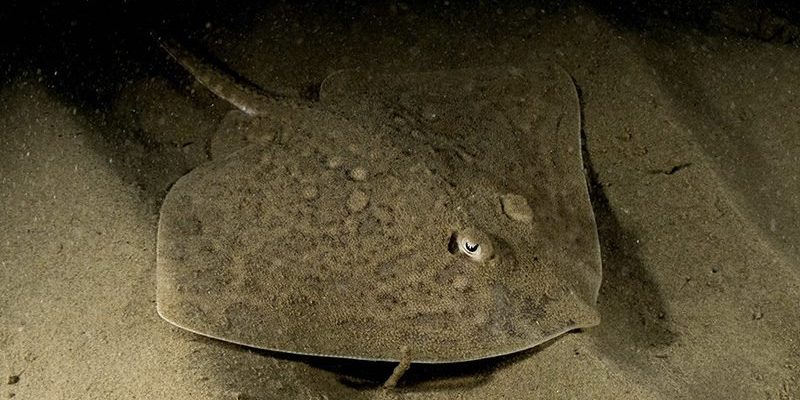
Imagine gliding through the calm waters of a coastal bay, and out of nowhere, a flat, winged creature swoops by beneath the surface. This isn’t a bird or a superhero in disguise, but rather the fascinating Thornback Ray. Known for its unique shape and intricate patterns, the Thornback Ray is a type of skate that captivates those lucky enough to spot it. With its flat body and broad pectoral fins, it looks like it’s flying through the water rather than swimming, giving it a distinct appeal.
The Thornback Ray is not just a pretty face; it plays a vital role in its ecosystem. These rays are often found in shallow coastal waters, where they hunt for food and interact with other marine life. With their thorny spines and camouflaged bodies, they can blend seamlessly with the ocean floor, making them crafty hunters in their own right. If you’re curious about the details of this peculiar creature, let’s dive deeper.
Physical Characteristics
The Thornback Ray is a sight to behold, sporting a flattened body that can reach widths of up to 1.5 meters (about 5 feet). Its color varies from a sandy brown to a more vibrant yellowish hue, often adorned with dark spots and intricate patterns that help it blend in with the ocean floor. This natural camouflage protects it from potential predators, like larger fish and sharks.
One of the most striking features of the Thornback Ray is its thorny back. These spines, which are actually modified dermal denticles, not only provide protection against predators but can also be intriguing to those observing them. When you get up close, you can see how these thorns are arranged, creating a textured appearance that is as beautiful as it is functional.
Additionally, like other rays, the Thornback Ray has a pair of large pectoral fins that stretch wide, giving it a graceful glide through the water. Its mouth is located on the underside of its body, perfectly adapted for its feeding habits. This design allows the Thornback Ray to suck in prey, mostly consisting of small fish and crustaceans, lurking beneath the sandy substrate.
Habitat and Distribution
Thornback Rays are primarily found in shallow coastal waters across the northeastern Atlantic Ocean, particularly from Norway down to the Mediterranean Sea and all the way to West Africa. They prefer sandy or muddy bottoms where they can easily camouflage and hunt. The adaptability of the Thornback Ray allows it to thrive in various environments, from estuaries to deeper sea beds.
You might come across these rays in bays, lagoons, and even around rocky shores. They are known to migrate, often following prey availability, which means seeing them is sometimes a matter of being in the right place at the right time. It’s an exciting prospect for marine enthusiasts and casual beachgoers alike.
During the warmer months, they tend to move into shallower waters, making them more visible to divers and snorkelers. In contrast, in colder months, they may shift to deeper areas to avoid the chilling temperatures. This seasonal movement helps ensure their survival and access to food sources.
Diet and Feeding Behavior
The diet of the Thornback Ray is primarily composed of small fish, crustaceans, and mollusks. These rays use their keen sense of smell and electroreception to hunt effectively, making them skilled predators. When foraging, they often bury themselves under the sand, lying in wait for unsuspecting prey to come near.
Once their prey is within reach, the Thornback Ray uses its mouth, located on the underside, to suck in the food. This feeding technique is efficient and allows them to consume a variety of small marine animals without much effort. It’s a bit like waiting for a snack to fall from the table—patience is key, and the rewards can be delicious!
An interesting aspect of their feeding behavior is how they can often be seen hunting in groups. This social feeding can increase their chances of capturing prey and provides a fascinating spectacle for observers. Imagine the dance of these rays as they glide in unison, working together to bring in their next meal.
Reproduction and Lifespan
Thornback Rays have a unique reproductive strategy known as ovoviviparity. This means that the eggs develop inside the female’s body, and the young hatch inside before being born live. After about 10-12 months of gestation, the female gives birth to around 5 to 25 pups, which are fully formed and immediately capable of swimming away.
The pups are about 15 cm long at birth and are miniature versions of their parents. This early independence is crucial, as it helps reduce the risk of predation. Female Thornback Rays reach sexual maturity at around 4 to 5 years of age, while males mature a bit earlier. This reproductive cycle helps maintain their population in the wild.
In terms of lifespan, Thornback Rays can live up to 15 years in the wild, although many factors can affect their longevity, such as environmental conditions and predation. Understanding their reproductive habits is essential for conservation efforts, as it helps ensure that their populations remain stable in the face of environmental changes and fishing pressures.
Conservation Status
While the Thornback Ray is not currently classified as endangered, it faces significant threats to its survival. Overfishing is one of the primary concerns, as these rays are sometimes caught unintentionally in fishing nets or targeted for their meat and skin. Additionally, habitat degradation due to pollution and climate change can impact their populations.
Conservation efforts are crucial to ensuring the future of the Thornback Ray. Sustainable fishing practices and habitat protection initiatives can help mitigate some of the threats they face. Many organizations are working to raise awareness about the importance of these creatures and the ecosystems they inhabit.
As a curious observer of marine life, you can play a role in conservation as well. Supporting local initiatives aimed at protecting marine habitats and responsibly consuming seafood are excellent ways to contribute to the preservation of these remarkable creatures. After all, we share this planet with them, and it’s our responsibility to protect their home.
Interesting Facts about Thornback Rays
| Scientific Name: | Dipturus species |
| Size: | Up to 1.5 meters (5 feet) wide |
| Habitat: | Shallow coastal waters, sandy/muddy substrates |
| Diet: | Small fish, crustaceans, mollusks |
| Reproduction: | Ovoviviparous (live birth from eggs) |
| Lifespan: | Up to 15 years |
How to Spot a Thornback Ray
If you’re eager to catch a glimpse of a Thornback Ray, the best places to look are shallow coastal zones during warm months. These rays often bask in the sunlight, making them easier to see. Tide pools and sandy areas near estuaries are great spots to explore. Just remember to look carefully, as their excellent camouflage can make them blend perfectly with their surroundings.
Diving or snorkeling in these regions can provide a closer encounter, but always be mindful of their habitat. If you do spot one, observe quietly from a distance to avoid startling it. Watching these elegant creatures glide through the water is a mesmerizing experience and one you won’t forget.
In addition to diving, some coastal tours offer opportunities to see Thornback Rays up close. These tours are often led by knowledgeable guides who can share insights into the behavior, habitat, and conservation of these fascinating animals. It’s a wonderful way to appreciate marine life while learning about the importance of preserving it.
FAQ
What is the main threat to Thornback Rays?
The primary threat to Thornback Rays is overfishing. Many of these rays are unintentionally caught in nets, which puts pressure on their populations. Additionally, habitat destruction and pollution can have significant negative impacts on their survival.
Are Thornback Rays dangerous to humans?
While Thornback Rays are not aggressive and generally pose no threat to humans, they do have the ability to deliver a painful sting if stepped on. It’s important to watch your step if wading in areas where they might be present.
What do Thornback Rays eat?
Thornback Rays primarily feed on small fish, crustaceans, and mollusks. They use their specialized hunting techniques to suck in prey lurking beneath the sand, making them effective predators in their habitat.
How do Thornback Rays reproduce?
Thornback Rays reproduce through a process called ovoviviparity, meaning the eggs develop inside the female’s body, and she gives live birth to fully formed pups. This reproductive strategy helps ensure that the young have a better chance of survival upon birth.
What is the lifespan of a Thornback Ray?
The lifespan of a Thornback Ray can reach up to 15 years in the wild. However, various factors such as environmental conditions and predation can influence their longevity.
Where can I find Thornback Rays?
Thornback Rays are mostly found in shallow coastal waters of the northeastern Atlantic Ocean, ranging from Norway to the Mediterranean Sea and down to West Africa. They prefer sandy or muddy bottoms where they can hide and hunt.
What is the size of a Thornback Ray?
Thornback Rays can grow up to 1.5 meters (about 5 feet) wide. Their flat bodies and wide pectoral fins contribute to their impressive size and unique appearance.
How can I help conserve Thornback Rays?
You can help conserve Thornback Rays by supporting sustainable fishing practices and participating in local conservation efforts. Being mindful of your seafood choices and advocating for marine habitat protection are crucial ways to make a difference.
Are Thornback Rays social animals?
While Thornback Rays are generally solitary, they can sometimes be seen hunting in groups. This social behavior can enhance their efficiency in capturing prey and offers a fascinating view for those observing them in their natural habitat.
What adaptations do Thornback Rays have for survival?
Thornback Rays have several adaptations for survival, including their flattened bodies for easy movement in the water, thorny spines for protection, and excellent camouflage to hide from predators. Their specialized feeding techniques also make them skilled hunters.
Can Thornback Rays be kept in aquariums?
While it is possible to keep Thornback Rays in aquariums, they require a large, well-maintained environment due to their size and specific habitat needs. Additionally, care should be taken to ensure that they are not subjected to stress and that they have ample room to swim and thrive.
What role do Thornback Rays play in their ecosystem?
Thornback Rays play a vital role in their marine ecosystems as both predators and prey. They help maintain the balance of populations of smaller fish and invertebrates while also serving as food for larger marine animals. Their presence is an indicator of a healthy marine environment.
How do Thornback Rays communicate with each other?
Thornback Rays primarily communicate through body language and movement rather than vocalizations. They may use their body position and swimming patterns to signal to one another, especially during mating or when competing for food.

